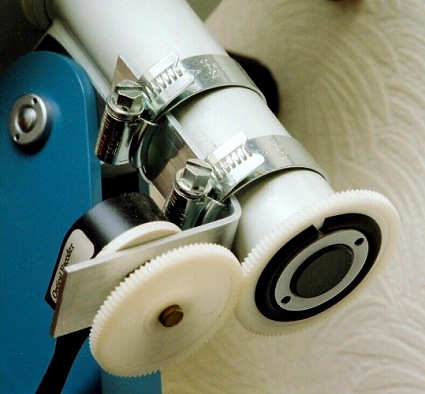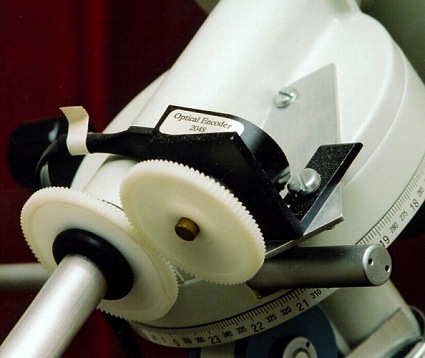|
|
|||||||||||
| A Computerised Telementor | |||||||||||
|
Sometime back I sold my Vixen SP having foolishly, as I thought, been persuaded to separate it from the installed Celestron Advanced Astromaster (CAA) Digital Setting Circle (DSC). For quite some time the parts of the CAA languished in a box. I offered them for sale, without success. Then, while reading a magazine review of the month’s latest electronic techno-wonder scope (never mind the optics, look at the processing power) it occurred to me that I could use the CAA on my Zeiss Telementor. The "T equatorial" mount is a german equatorial and thus in essence very similar to the Vixen SP. I reasoned that provided the two CAA gears could be securely attached to the RA and DEC shafts of the mount it should work. And of course lack of motor-driven RA was not a problem - the encoders "read" the movement of the shafts : if there’s no actual movement then the computer shows an RA reading changing at the sidereal rate. The idea of a traditionally crafted quality telescope retrofitted with a DSC seemed much more appealing than integrated computer scope, particularly at the high price at which these are offered in the UK. Experience of course counselled
against the whole idea. McCaughan’s recension of Murphy’s law states "No
two items of astronomical equipment will ever fit together, even if designed
to." (This is not true of equipment from Astro-Physics Inc. but then, as
everyone knows, toast always lands butter-side up in Illinois). Somewhat
to my surprise it was not only possible to marry the two: it was easy.
Specification of the Celestron Advanced Astromaster DSC The Celestron Advanced Astromaster was originally developed to fit Celestron’s line of fork-mounted Schmidt Cassegrain Telescopes of the C-8 and Ultima-8 vintage (late 1980s, early 1990s). It was also supplied with hardware suitable for attaching it to the Super Polaris mount generally sold in the US under the Celestron brand. The CAA predates the wide availability of computerised scopes. It consists of a small hand-held battery-powered computer with a one-line LED display, a pair of optical encoders and pairs of nylon gears. In each case one gear is mounted on the shaft of the mount; the other on the shaft of the optical encoder. The encoders are mounted so that the pairs of gears mesh, and accordingly any movement in the mount shaft causes rotation of the encoder shaft. Overall the CAA is quite similar to an early JMI NGC-Max, and to an item offered some years back by Lumicon. By today's standards the
onboard database is a little sparse:
The most useful modes available are :
The encoders are relatively
low-resolution (2048 steps/revolution) but in practice the system returns
entirely satisfactory accuracy : objects are seldom far from the centre
of field in a 15mm Plossl.
Operation of the computerised scope
The good news is that no
surgery on the telescope was necessary. The most radical step was to remove
one bolt from the four on the front of the RA assembly and replace it with
a longer one.
The only real work is to produce some suitable mounting hardware. A single right-angled strip of 2mm aluminium is strapped to the rear of the RA housing by two "jubilee" clips. The encoder and gear is mounted through the strip’s bent end and engages with the gear wrapped round the moving part at the very rear of the RA housing. The Dec. encoder sits on an angled piece of aluminium bolted to the front of the RA housing. Here are a few pointers in
order to make things easier
If you are interested in pursuing this sort of project I suggest you look for a second-hand DSC set. So long as it was supplied for a German Equatorial Mount, and includes its encoders and gears it ought to be possible to adapt it to the Zeiss mount fairly easily. I have seen a couple advertised - presumably by people upgrading the SP mount to SkySensor "GoTo" spec. JMI have also made a number of models over the last decade - all the way from a basic RA-Dec digital readout to some very powerful computers with big databases and intelligent features. Obviously no-one should make a significant investment without first satisfying themselves that their intended DSC will be compatible. And make sure that you check the specific set you intend to install : Celestron and JMI have changed the design and spec of their models several times over the last decade. Needless to say I should be pleased to offer any help I can to anyone undertaking a similar project. Neil McCaughan, 2001
|
|||||||||||

